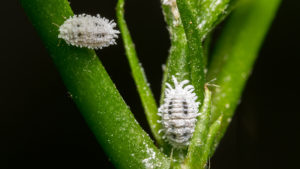🍋Citrus Tree care GONE WRONG! Pests, Malnourishment, Black Mold - EEK!
My Citrus Tree care has definitely gone wrong. I should have attended the pests much sooner and kept up with my fertilizing schedule. In order for me to learn the best, I truthfully wanted to see the ‘worst that can happen’ but I probably over did it. My citrus tree is suffering. I’m going to nourish it back to life and give you an update in the summer – so stay tuned! AND don’t forget to check out the video below!
Citrus Tree - Pests
Mealy Bugs
 Mealy bugs are white and waxy. They live along the leaf veins, the underside of the leaves, and travel in clusters. The insect excretes honeydew, which causes leaves to become sticky. Ants are attracted to the sweet liquid. Look for near by ant piles because ants will protect mealy bugs from their predators in order for them to feast on the honeydew.
Mealy bugs are white and waxy. They live along the leaf veins, the underside of the leaves, and travel in clusters. The insect excretes honeydew, which causes leaves to become sticky. Ants are attracted to the sweet liquid. Look for near by ant piles because ants will protect mealy bugs from their predators in order for them to feast on the honeydew.

With time, a black mold, called sooty mold, can grow on the honeydew giving the leaves a dirty, sooty appearance. Plants infested with mealybugs become weak, may wilt and turn yellow, and eventually die.

Also, look in the underside of the leaves for eggs. Eggs hatch in about 2 weeks. The young mature in 6–8 weeks. Several generations can occur in the same year.
You can use Neem Oil as a form of pest control.
Leaf Miner
 Leaf miner looks like yellow, squiggly lines on the leaves. It is the larva of flies, moths, and sawflies eating off the leaves. If the tree is healthy, it can protect itself by producing a chemical called tannin that deters insects away.
Leaf miner looks like yellow, squiggly lines on the leaves. It is the larva of flies, moths, and sawflies eating off the leaves. If the tree is healthy, it can protect itself by producing a chemical called tannin that deters insects away.
Captain Jack’s by Bonide works really well to contain the infestation.
fertilizers
Fertilize your trees in February, after they finished blooming, and in July. You want to fertilize when they are setting fruit. They are heavy feeders at this time.
This year I’ll be using my worm castings from my worm farm and adding in Citrus Tone from Espoma.
Where I purchased my Citrus Trees
You can visit your local garden center, The Arbor Gate is mine, and check their varieties first. I love supporting local.
All of my trees are from Costco because I didn’t check The Arbor Gate at the time, but you can also find them at Sam’s Club or your normal boxed stores; such as – Lowes, Home Depot, Walmart, etc. all of these places have garden centers that will carry citrus trees during the Spring.
My tree varieties
I know you are probably wondering what type of trees I have. This is my list:
Citrus Trees from Costco are from- https://www.saxonbecnelandsons.com/
Persian Lime
PERSIAN LIME – A medium spreading tree that bears fragrant blossoms and shiny fruit all year in cooler climates. Contains few thorns and is very cold tolerant. The fruit is medium to small in size and is very juicy. Usually is picked green and is yellow when mature; does not hold well on the tree.
Lisbon Lemon
LISBON LEMON – The tree is large, thorny, and stands upright with dense foliage. The flowers and new growth when appearing tend to have a purple tint. Fruit is medium in size and best picked when ripened; also tends to over ripen quite easily.
Chandler Red Pummelo
CHANDLER RED PUMMELO – The tree is very large in size bearing excellent quality fruit. This fruit is large and typically ripens around late December to January. Like the Ruby Red and Rio Red has a pinkish inside when peeled open.
Moro Blood Orange
MORO BLOOD ORANGE – Tree appears to be medium in size with a round top. This blood orange tends to bear heavily but usually in alternate years. Fruit is normally borne in clusters in a very attractive setting appearing outside of the canopy. Fruit is medium in size, ripening very early with a distinct aroma. The flesh of the fruit is a violet to burgundy; rind orange with a pink blush, and is known to hold well on the tree.
Hamlin (Louisiana) Sweet Orange
HAMLIN (LOUISIANA) SWEET ORANGE – This tree is considered to be medium to large in size, and usually produces a heavy annual crop. The sweet orange is also known to tolerate the cold. The fruit size is small to medium, usually seedless, and is also known to ripen early. The peel is very tender and is very juicy with low acidity.
Dancy Tangerine
DANCY TANGERINE – is one of the oldest and formerly most popular American citrus varieties, but is now rarely sold. It has an intense, medium-sweet flavor, and its juice is more strongly-flavored than orange juice. It is known for its loose, pliable peel, which is mainly orange flavedo, with very little bitter white pith. This allows the peel to be eaten fresh and used to flavor dishes like tangerine beef. The Dancy may be a pure mandarin – not a hybrid.
Play Video

